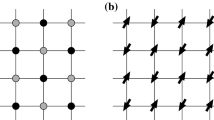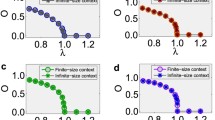Abstract
We consider a quantum many-body system on a lattice which exhibits a spontaneous symmetry breaking in its infinite-volume ground states, but in which the corresponding order operator does not commute with the Hamiltonian. Typical examples are the Heisenberg antiferromagnet with a Néel order and the Hubbard model with a (superconducting) off-diagonal long-range order. In the corresponding finite system, the symmetry breaking is usually “obscured” by “quantum fluctuation” and one gets a symmetric ground state with a long-range order. In such a situation, Horsch and von der Linden proved that the finite system has a low-lying eigenstate whose excitation energy is not more than of orderN −1, whereN denotes the number of sites in the lattice. Here we study the situation where the broken symmetry is a continuous one. For a particular set of states (which are orthogonal to the ground state and with each other), we prove bounds for their energy expectation values. The bounds establish that there exist ever-increasing numbers of low-lying eigenstates whose excitation energies are bounded by a constant timesN −1. A crucial feature of the particular low-lying states we consider is that they can be regarded as finite-volume counterparts of the infinite-volume ground states. By forming linear combinations of these low-lying states and the (finite-volume) ground state and by taking infinite-volume limits, we construct infinite-volume ground states with explicit symmetry breaking. We conjecture that these infinite-volume ground states are ergodic, i.e., physically natural. Our general theorems not only shed light on the nature of symmetry breaking in quantum many-body systems, but also provide indispensable information for numerical approaches to these systems. We also discuss applications of our general results to a variety of interesting examples. The present paper is intended to be accessible to readers without background in mathematical approaches to quantum many-body systems.
Similar content being viewed by others
References
I. Affleck,J. Phys. Condens. Matter 1:3047 (1989).
I. Affleck, T. Kennedy, E. H. Lieb, and H. Tasaki,Phys. Rev. Lett. 59:799 (1987);Commun. Math. Phys. 115:477 (1988).
I. Affleck and E. H. Lieb,Lett. Math. Phys. 12:57 (1986).
A. Aizenman, E. B. Davies, and E. H. Lieb,Adv. Math. 28:84 (1978).
A. Aizenman and E. H. Lieb,J. Stat. Phys. 24:279 (1981).
P. W. Anderson,Phys. Rev. 86:694 (1952).
P. Azaria, B. Delmotte, and D. Mouhanna,Phys. Rev. Lett. 70:16 (1993).
B. Bernu, C. Lhuillier, and L. Pierre,Phys. Rev. Lett. 69:2590 (1992).
O. Bratteli and D. W. Robinson,Operator Algebras and Quantum Statistical Mechanics I, II (Springer, 1979).
F. J. Dyson, E. H. Lieb, and B. Simon,J. Stat. Phys. 18:335 (1978).
F. H. L. Essller, V. E. Korepin, and K. Schoutens,Phys. Rev. Lett. 68:2960 (1992);70:73 (1993).
M. Fannes, B. Nachtergaele, and R. F. Werner,Europhys. Lett.,10:633 (1989);Commun. Math. Phys. 144:443 (1992).
M. Hagiwara, K. Katsumata, I. Affleck, B. I. Halperin, and J. P. Renard,Phys. Rev. Lett. 65:3183 (1990).
F. D. M. Haldane,Phys. Lett. 93A:464 (1983);Phys. Rev. Lett. 50:1153 (1983).
P. Horsch and W. von der Linden,Z. Phys. B 72:181 (1988).
E. Jordão Neves and J. Fernando Perez,Phys. Lett. 114A:331 (1986).
C. Kaiser and I. Peschel,J. Phys. A. 22:4257 (1989).
T. A. Kaplan, P. Horsch, and W. von der Linden,J. Phys. Soc. Jpn. 11:3894 (1989).
T. A. Kaplan, W. von der Linden, and P. Horsch,Phys. Rev. B 42:4663 (1990).
T. Kennedy,J. Phys. Condensed Matter 2:5737 (1990).
T. Kennedy, E. H. Lieb, and B. S. Shastry,J. Stat. Phys. 53:1019 (1988).
T. Kennedy, E. H. Lieb, and B. S. Shastry,Phys. Rev. Lett. 61:2582 (1988).
T. Kennedy and H. Tasaki,Phys. Rev. B 45:304 (1992);Commun. Math. Phys. 147:431 (1992).
M. Kikuchi, Y. Okabe, and S. Miyashita,J. Phys. Soc. Jpn. 59:492 (1990).
A. Klümper, A. Schadschneider, and J. Zittarz,J. Phys. A 24:L995 (1991).
T. Koma and H. Tasaki,Phys. Rev. Lett. 70:93 (1993);Commun. Math. Phys. 158:191 (1993).
K. Kubo,Phys. Rev. Lett. 61:110 (1988).
K. Kubo and T. Kishi,Phys. Rev. Lett. 61:2585 (1988).
P. W. Leung and K. J. Runge,Phys. Rev. B 47:5861 (1993).
E. H. Lieb,Phys. Rev. Lett. 62:1201 (1989).
E. H. Lieb, inProceedings “Advances in Dynamical Systems and Quantum Physics” Capri, May 1993 (World Scientific, to appear), and inProceedings of 1993 NATO ASW “The Physics and Mathematical Physics of the Hubbard Model” (Plenum, to appear).
E. H. Lieb and D. C. Mattis,J. Math. Phys. 3:749 (1962).
W. Marshall,Proc. R. Soc. Lond. A 232:48 (1955).
T. Matsubara and H. Matsuda,Prog. Theor. Phys. 16:569 (1956).
T. Momoi,J. Stat. Phys. 75:707 (1994).
T. Momoi, Preprint.
A. Montorsi, ed.,Hubbard Model—A Reprint Volume (World Scientific, 1992).
M. den Nijs and K. Rommelse,Phys. Rev. B 40:4709 (1989).
H. Nishimori, K. Kubo, Y. Ozeki, Y. Tomita, and T. Kishi,J. Stat. Phys. 55:259 (1989).
H. Nishimori and Y. Ozeki,J. Phys. Soc. Jpn. 58:1027 (1989).
Y. Ozeki, H. Nishimori, and Y. Tomita,J. Phys. Soc. Jpn. 58:82 (1989).
M. Reed and B. Simon,Method of Modern Mathematical Physics I: Functional Analysis (Academic Press, 1972).
D. Ruelle,Statistical Mechanics: Rigorous Results (Benjamin, 1969).
S.-Q. Shen and Z.-M. Qiu,Phys. Rev. Lett. 71:4238 (1993).
B. Simon,Statistical Mechanics of Lattice Gases I (Princeton University Press, 1993).
H. Tasaki,Phys. Rev. Lett. 66:798 (1991).
L. Van Hove,Physica 15:951 (1949).
Author information
Authors and Affiliations
Rights and permissions
About this article
Cite this article
Koma, T., Tasaki, H. Symmetry breaking and finite-size effects in quantum many-body systems. J Stat Phys 76, 745–803 (1994). https://doi.org/10.1007/BF02188685
Received:
Accepted:
Issue Date:
DOI: https://doi.org/10.1007/BF02188685




